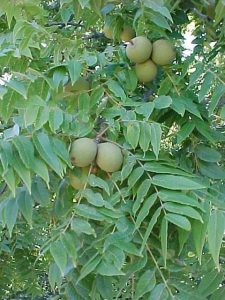Black Walnut Toxicity refers to the inhibition of the growth of plants located near black walnut trees. This is due to a type of allelopathy, where one plant produces a substance that inhibits growth of another plant growing nearby. Black walnut produces a chemical called juglone, which occurs naturally in the roots, buds, and nut hulls. Juglone may build up in the root zone or drip line of a walnut tree and result in poor growth of sensitive plants, and roots can continue to produce juglone for a year or two after a tree is cut down. Plants that are sensitive may turn yellow, wilt, be stunted, or die. Symptoms may be mistaken for nutrient deficiencies or plant disease, but plants will not recover. Some plants are more sensitive than others, including tomato, potato, pepper, cabbage, columbine, lily peony, blueberry, hydrangea, lilac, privet, paper birch, white pine, Norway spruce, silver maple, and saucer magnolia. Landscape beds and gardens should be sited away from black walnut, and black walnut should not be chipped for mulch. Plants that are tolerant of black walnut toxicity include red maple, river birch, hornbeam, buckeye, catalpa, red bud, white oak, fringe tree, forsythia, ninebark, elderberry, juniper, hemlock, arborvitae, and many herbaceous perennials. For a complete list, from the Morton Arboretum, see the following link: http://www.mortonarb.org/files/Black%20Walnut%20toxicity%2C%20plants%20tolerant%20of%202014.pdf
Plants that are sensitive may turn yellow, wilt, be stunted, or die. Symptoms may be mistaken for nutrient deficiencies or plant disease, but plants will not recover. Some plants are more sensitive than others, including tomato, potato, pepper, cabbage, columbine, lily peony, blueberry, hydrangea, lilac, privet, paper birch, white pine, Norway spruce, silver maple, and saucer magnolia. Landscape beds and gardens should be sited away from black walnut, and black walnut should not be chipped for mulch. Plants that are tolerant of black walnut toxicity include red maple, river birch, hornbeam, buckeye, catalpa, red bud, white oak, fringe tree, forsythia, ninebark, elderberry, juniper, hemlock, arborvitae, and many herbaceous perennials. For a complete list, from the Morton Arboretum, see the following link: http://www.mortonarb.org/files/Black%20Walnut%20toxicity%2C%20plants%20tolerant%20of%202014.pdf
NFG 1/4/2016
